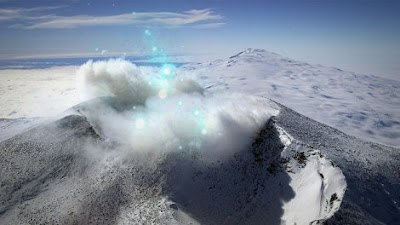Unknown Particles Coming From Antarctica
NASA's Antarctic Impulsive Transient Antenna (ANITA) stays high above Antarctica and detects high-energy particles from space that reach Earth. Strangely, the antenna has detected some particles coming out from the ground and this may result in massive changes to the Standard Model of particle physics.
The Antenna was built to find particles such as neutrinos falling from the sky. It was put on a high altitude balloon because high-energy neutrinos are too energetic to make it through the atmosphere without colliding with something (low-energy neutrinos can move through matter easily without interacting with it).
When the scientists then spotted particles coming from the other direction (from the Earth) it meant that high energy particles must have come from space and passed through the entire Earth. High energy neutrinos have less than a 1/1000000 chance of making it through the Earth yet 2 particles were seen to have come from the ground. This means it was very unlikely that these particles were neutrinos...
To make things even weirder, some astrophysicists from Penn State University showed that IceCube (another neutrino observatory in Antarctica) detected similar particles but no one had connected this to the data from ANITA. No high-energy particle in the Standard Model should be able to do pass through the entire Earth. The most logical conclusion is that this particle is not in the Standard Model
Penn State researches say that particle has less than a 1/3500000 chance of being in the Standard Model.
 |
| The Standard Model of particle physics |
What Particle?
There is an idea in physics called supersymmetry. Currently the Standard Model only assumes symmetries such as time and space translation symmetry. If you assume all types of symmetries, such as some weird quantum mechanical symmetries, then the Standard Model changes and all particles appear with a supersymmetric partner.Currently, the best guess is that ANITA and IceCube have observed supersymmetric particles called stau sleptons (the supersymmetric version of the tau lepton).
More data is going to be needed to confirm any kind of new particle. Physicists will have to look at previous data from ANITA and IceCube and see if any similar data was collected and just left unnoticed. More instruments will also need to be able to detect these events. If this all works and it turns out these particles are supersymmetric partners, then the next few years will be exciting for physics. We may discover ways to detect particles that have been hypothesized but never observed.
Thanks for reading. If you enjoyed this post or any of my others, follow and subscribe to my blog. Feel free to discuss anything related to this post or ask questions in the comments below.
Did you see my previous post? Click the link below to check it out
You Are Moving Through TIME At The Speed Of Light: Time Dilation Intuition
Want to see my next post? Click the link below
Do Headlights Work At The Speed Of Light? - Relativistic Velocity Addition

Comments
Post a Comment